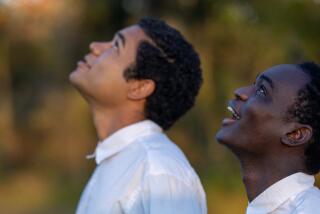Movie review: ‘Children of Paradise’ is critic’s personal favorite
To see Marcel Carné’s “Children of Paradise” under any circumstances is to be transported and transformed by cinema. To see it in the version showing at Laemmle’s Royal in West Los Angeles and Playhouse 7 in Pasadena is, if possible, even more special.
Written by Carné’s frequent collaborator Jacques Prévert, this 1945 film is more than the acme of a style known as poetic realism, it is often considered to be the greatest French film ever made. Called by critic James Agee “close to perfection ... guaranteed to make you very happily drunk,” it is also the title I most often cite when asked to pick an all-time personal favorite.
Because of its legendary status, “Children of Paradise” (“Les enfants du paradis” in the original French) became the first motion picture to benefit from a 4K digital restoration of its original negative. Though digital prints can seem overly precise, this one is truly warm and welcoming, and to luxuriate in the film’s 3-hour, 10-minute length is to experience this masterpiece as it hasn’t been experienced since the day it opened.
Set in the teeming environs of 1830s Paris, the “Paradise” title refers to those who inhabit the highest balconies (and the cheapest seats) in the myriad theaters of that city’s Boulevard du Crime (the nickname of Boulevard du Temple). These spectators are the equivalent of Shakespeare’s groundlings, those whose love of theatrical spectacle is in inverse proportion to their ability to pay for it.
Although the film has much to say about the world of theater, it is not about performance but rather the exaltations and mortifications of romantic love. Bursting with life and spirit, the film explores love both requited and unreturned, passionate and cool.
Its visual richness and splendid dialogue, when added to the humanity and complexity of its relationships, makes this one of the few films that has the durability and emotional texture of a great 19th century novel. As a piece of romantic/dramatic cinema, its peers are few, its superiors simply nonexistent.
The woman at the center of all the excitement is Garance (played by Arletty), and we meet her up to her neck in a tub of water, posing as the Naked Truth in a Boulevard du Crime sideshow. Beautiful, enigmatic, capricious and unashamed, Garance is the fulcrum around which the plot turns. No less than four men, many based on real-life characters, come to consider her the exquisite woman of their dreams.
There is the chilling Lacenaire (Marcel Herrand), a cold-eyed and confident criminal/philosopher, and the equally self-centered, ramrod-straight Count de Montray (Louis Salou), one of the richest men in France. From the theater comes Frédérick Lemaître (Pierre Brasseur), a practiced seducer and the preeminent actor of his day, and, most memorably of all, Baptiste Debureau, the man who revolutionized the art of pantomime.
Jean-Louis Barrault’s legendary performance as the lovelorn Baptiste presents an ultimate romantic dreamer, intoxicated by Garance but passionately loved in turn by the heartbreakingly devoted Nathalie (María Casares).
Though the artfully intertwined relationships of this group are the emotional center of “Children of Paradise,” the interplay among many of the supporting characters is just as vividly rendered.
The malevolent rag picker and fence Jéricho (Pierre Renoir, the director’s brother), the softhearted hood Avril (Fabien Loris), the coquettish landlady Madame Hermine (Jeanne Marken), PierrePalau’stirelessly apoplectic theater director — these characters are indispensable in the creation of this unparalleled romantic tapestry.
Making “Children of Paradise’s” success even more impressive is the fact that it was shot, first in Nice and then in Paris, during the harsh German occupation of France. Key creators like art director Alexandre Trauner and composer Joseph Kosma worked in secret because they were Jewish and in hiding. As the end of filming and the end of the war neared, Carné maneuvered to have the film’s premiere take place in a liberated Paris, which, on March 9, 1945, it did.
With this new print available for big screen viewing, “Children of Paradise” is not to be missed.
-
“Children of Paradise”
No MPAA rating; In French with English subtitles
Running time: 190 minutes
Playing: Laemmle’s Royal Theatre, West Los Angeles; Laemmle’s Playhouse 7, Pasadena
More to Read
The biggest entertainment stories
Get our big stories about Hollywood, film, television, music, arts, culture and more right in your inbox as soon as they publish.
You may occasionally receive promotional content from the Los Angeles Times.











